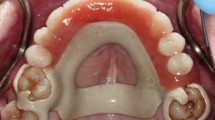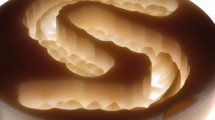Abstract
The field of science and research is ever changing and the scientific discipline of prosthodontics is no exception. The practice of prosthodontics and the supporting technology involved has evolved tremendously from the traditional to the contemporary. As a result of continual developments in technology, new methods of production and new treatment concepts may be expected. Clinicians must have certain basic knowledge if they are to benefit from these new procedures. This article reviews the contemporary trends in the field of prosthodontics and provides an insight into what one might expect in the near future.
Similar content being viewed by others

References
Murray MD, Marvell MD (1993) The evolution of complete denture base. Aust Dent J 38:216–219
Birnbaum NS, Aaronson HB (2008) Dental impressions using 3D digital scanners: virtual becomes reality. Compend Contin Educ Dent 29:494, 496, 498–505
Sam FE, Bonnick AM (2011) Office computer systems for the dental office. Dent Clin North Am 55:549–557
Bhambhani R, Bhattacharya J, Sen Kr S (2012) Digitization and its futuristic approach in prosthodontics. J Indian Prosthodont Soc. 12:8–15
Konukseven EI, Onder ME, Mumcuoglu E, Kisnisci RS (2010) Development of a visio-haptic integrated dental training simulation system. J Dent Educ 74:880–891
Gluch JI, Stewart CL, Buchanan JA, Hammrich PL (1999) Virtual reality technology in preclinical laboratory: differential student responses based on learning styles. J Dent Educ 63:58
Stewart DL, Gluch JI, Hammrich PL, Buchanan JA (1999) Virtual reality technology versus traditional preclinical lab: perceptions of first-year dental students. J Dent Educ 63:74
Quinn F, Keogh P, McDonald A, Hussey D (2003) A study comparing the effectiveness of conventional training and virtual reality simulation in the skills acquisition of junior dental students. Eur J Dent Educ 7:164–169
Jasinevicius TR, Landers M, Nelson S, Urbankova A (2004) An evaluation of two dental simulation systems: virtual reality versus contemporary non-computer-assisted. J Dent Educ 68:1151–1162
Spyropoulou PE, Razzoog ME, Duff RE, Chronaios D, Saglik B, Tarrazzi DE (2011) Maxillary implant-supported bar overdenture and mandibular implant-retained fixed denture using CAD/CAM technology and 3-D design software: a clinical report. J Prosthet Dent 105:356–362
Boeckler AF, Lee H, Stadler A, Setz JM (2009) Prospective observation of CAD/CAM titanium ceramic single crowns: a three-year follow up. J Prosthet Dent 102:290–297
Wittneben JG, Wright RF, Weber HP, Gallucci GO (2009) A systematic review of the clinical performance of CAD/CAM single-tooth restorations. Int J Prosthodont 22:466–471
Kapos T, Ashy LM, Gallucci GO, Weber HP, Wismeijer D (2009) Computer-aided design and computer-assisted manufacturing in prosthetic implant dentistry. Int J Oral Maxillofac Implants 24:110–117
Abduo J, Lyons K, Bennani V, Waddell N, Swain M (2011) Fit of screw-retained fixed implant frameworks fabricated by different methods: a systematic review. Int J Prosthodont 24:207–220
Freedman M, Quinn F, O’Sullivan M (2007) Single unit CAD/CAM restorations: a literature review. J Ir Dent Assoc 53:38–45
Syrek A, Reich G, Ranftl D, Klein C, Cerny B, Brodesser J (2010) Clinical evaluation of all-ceramic crowns fabricated from intraoral digital impressions based on the principle of active wavefront sampling. J Dent 38:553–559
Persson AS, Odén A, Andersson M, Sandborgh-Englund G (2009) Digitization of simulated clinical dental impressions: virtual three-dimensional analysis of exactness. Dent Mater 25:929–936
Ender A, Mehl A (2011) Full arch scans: conventional versus digital impressions–an in vitro study. Int J Comput Dent 14:11–21
Güth JF, Keul C, Stimmelmayr M, Beuer F, Edelhoff D (2013) Accuracy of digital models obtained by direct and indirect data capturing. Clin Oral Investig 17:1201–1208
Flügge TV, Schlager S, Nelson K, Nahles S, Metzger MC (2013) Precision of intraoral digital dental impressions with iTero and extraoral digitization with the iTero and a model scanner. Am J Orthod Dentofacial Orthop 144:471–478
Beuer F, Schweiger J, Edelhoff D (2008) Digital dentistry: an overview of recent developments for CAD/CAM generated restorations. Br Dent J 204:505–511
Liu PR (2005) A panorama of dental CAD/CAM restorative systems. Compend Contin Educ Dent 26:507–512
Miyazaki T, Hotta Y (2011) CAD/CAM systems available for the fabrication of crown and bridge restorations. Aust Dent J 56:97–106
Davidowitz G, Kotick PG (2011) The use of CAD/CAM in dentistry. Dent Clin North Am 55:559–570
Kordass B, Gärtner C, Söhnel A, Bisler A, Voss G, Bockholt U et al (2002) The virtual articulator in dentistry: concept and development. Dent Clin North Am 46:493–506
Maestre-Ferrín L, Romero-Millán J, Peñarrocha-Oltra D, Peñarrocha-Diago M (2012) Virtual articulator for the analysis of dental occlusion: an update. Med Oral Patol Oral Cir Bucal 17:160–163
Goodacre CJ, Garbacea A, Naylor WP, Daher T, Marchack CB, Lowry J (2012) CAD/CAM fabricated complete dentures: concepts and clinical methods of obtaining required morphological data. J Prosthet Dent 107:34–46
AvaDent Digital Dentures; Global Dental Science LLC. Available at: http://www.avadent.com. Accessed 24 Nov 2013
Bidra AS, Taylor TD, Agar JR (2013) Computer-aided technology for fabricating complete dentures: systematic review of historical background, current status, and future perspectives. J Prosthet Dent 109:361–366
Van Noort R (2012) The future of dental devices is digital. Dent Mater 28:3–12
Wu G, Zhou B, Bi Y, Zhao Y (2008) Selective laser sintering technology for customized fabrication of facial prostheses. J Prosthet Dent 100:56–60
Zemnick C, Woodhouse SA, Gewanter RM, Raphael M, Piro JD (2007) Rapid prototyping technique for creating a radiation shield. J Prosthet Dent 97:236–241
Liacouras P, Garnes J, Roman N, Petrich A, Grant GT (2011) Designing and manufacturing an auricular prosthesis using computed tomography, 3-dimensional photographic imaging, and additive manufacturing: a clinical report. J Prosthet Dent 105:78–82
Barker TM, Earwaker WJ, Lisle DA (1994) Accuracy of stereolithographic models of human anatomy. Australas Radiol 38:106–111
Choi JY, Choi JH, Kim NK, Kim Y, Lee JK, Kim MK et al (2002) Analysis of errors in medical rapid prototyping models. Int J Oral Maxillofac Surg 31:23–32
Bill JS, Reuther JF, Dittman W, Kubler N, Meier JL, Pistner H et al (1995) Stereolithography in oral and maxillofacial operation planning. Int J Oral Maxillofac Surg 24:98–103
Mankovich NJ, Samson D, Pratt W, Lew D, Beumer J 3rd (1994) Surgical planning using three-dimensional imaging and computer modeling. Otolaryngol Clin North Am 27:875–889
Lu L, Fuh JY, Wong YS (2001) Laser-induced materials and processes for rapid prototyping. Springer-Verlag, New York, pp 91–95
Noorani RI (2005) Rapid prototyping: principles and applications. Wiley, Hoboken, pp 38–42
Ibrahim D, Broilo TL, Heitz C, de Oliveira MG, de Oliveira HW, Nobre SM et al (2009) Dimensional error of selective laser sintering, three-dimensional printing and PolyJet models in the reproduction of mandibular anatomy. J Craniomaxillofac Surg 37:167–173
Murugesan K, Anandapandian PA, Sharma SK, Vasantha Kumar M (2012) Comparative evaluation of dimension and surface detail accuracy of models produced by three different rapid prototype techniques. J Indian Prosthodont Soc 12:16–20
Smith S, Dvorak D (1998) Tool path strategies for high speed milling aluminium work pieces with thin webs. Mechatronics 8:291–300
Williams RJ, Bibb R, Rafik T (2004) A technique for fabricating patterns for removable partial denture frameworks using digitized casts and electronic surveying. J Prosthet Dent 91:85–88
Williams RJ, Bibb R, Eggbeer D, Collis J (2006) Use of CAD/CAM technology to fabricate a removable partial denture framework. J Prosthet Dent 96:96–99
Ganz SD (2011) Cone beam computed tomography-assisted treatment planning concepts. Dent Clin North Am 55:515–536
Spector L (2008) Computer-aided dental implant planning. Dent Clin North Am 52:761–775
Lal K, White GS, Morea DN, Wright RF (2006) Use of stereolithographic templates for surgical and prosthodontic implantplanning and placement. Part I. The concept. J Prosthodont 15:51–58
Sarment DP, Sukovic P, Clinthorne N (2003) Accuracy of implant placement with a stereolithographic surgical guide. Int J Oral Maxillofac Implants 18:571–577
Schneider D, Marquardt P, Zwahlen M, Jung RE (2009) A systematic review on the accuracy and the clinical outcome of computer-guided template-based implant dentistry. Clin Oral Implants Res 20:73–86
Jung RE, Schneider D, Ganeles J, Wismeijer D, Zwahlen M, Hämmerle CH, Tahmaseb A (2009) Computer technology applications in surgical implant dentistry: a systematic review. Int J Oral Maxillofac Implants 24:92–109
Grossmann Y, Pasciuta M, Finger IM (2006) A novel technique using a coded healing abutment for the fabrication of a CAD/CAM titanium abutment for an implant supported restoration. J Prosthet Dent 95:258–261
Telleman G, Raghoebar GM, Vissink A, Meijer HJ (2011) The use of a coded healing abutment as an impression coping to design and mill an individualized anatomic abutment: a clinical report. J Prosthet Dent 105:282–285
Nayyar N, Yilmaz B, McGlumphy E (2013) Using digitally coded healing abutments and an intraoral scanner to fabricate implant-supported, cement-retained restorations. J Prosthet Dent 109:210–215
Ozak ST, Ozkan P (2013) Nanotechnology and dentistry. Eur J Dent 7:145–151
Robert A, Freitas JR (2010) Nanodentistry: cover story. JADA 131:1559–1565
Saravana RK, Vijayalaksmi R (2006) Nanotechnology in dentistry. Ind J Dent Res 17:62–65
Mantri SS, Mantri SP (2013) The nano era in dentistry. J Nat Sci Biol Med 4:39–44
Rudra Pratap (2005) Engaging Private Enterprise in Nanotech Research in India: ICS, Trieste, February, 675–680
Egusa H, Sonoyama W, Nishimura M, Atsuta I, Akiyama K (2012) Stem cells in dentistry–part I: stem cell sources. J Prosthodont Res 56:151–165
Koyano K (2012) Toward a new era in prosthodontic medicine. J Prosthodont Res 56:1–2
Egusa H, Sonoyama W, Nishimura M, Atsuta I, Akiyama K (2012) Stem cells in dentistry–Part II: clinical applications. J Prosthodont Res 56:229–248
Duailibi MT, Duailibi SE, Young CS, Bartlett JD, Vacanti JP, Yelick PC (2004) Bioengineered teeth from cultured rat tooth bud cells. J Dent Res 83:523–528
Ohazama A, Modino SA, Miletich I, Sharpe PT (2004) Stem-cell based tissue engineering of murine teeth. J Dent Res 83:518–522
Duailibi SE, Duailibi MT, Zhang W, Asrican R, Vacanti JP, Yelick PC (2008) Bioengineering dental tissues grown in the rat jaw. J Dent Res 87:745–750
Author information
Authors and Affiliations
Corresponding author
Rights and permissions
About this article
Cite this article
Prithviraj, D.R., Bhalla, H.K., Vashisht, R. et al. Revolutionizing Restorative Dentistry: An Overview. J Indian Prosthodont Soc 14, 333–343 (2014). https://doi.org/10.1007/s13191-014-0351-5
Received:
Accepted:
Published:
Issue Date:
DOI: https://doi.org/10.1007/s13191-014-0351-5



